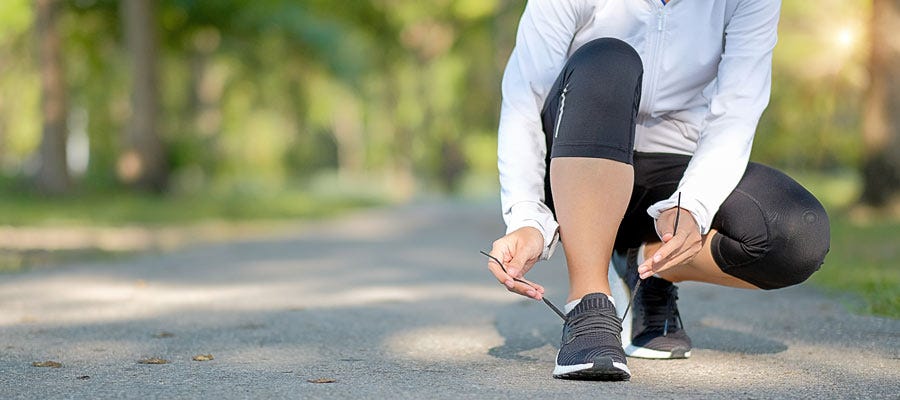If you live with diabetes, you may have been told by a healthcare professional that physical activity can help you manage the condition. But this doesn’t have to mean making a huge investment in a gym membership or workout gear. Daily walking is often recommended as one of the best exercises for people with diabetes. It’s low impact and low risk, freely accessible for almost everyone, and simple to fit into a busy schedule.
Health Benefits of Walking
The American Diabetes Association recommends that most adults with type 1 diabetes get at least 150 minutes of aerobic exercise per week. Moderate intensity activities like brisk walking provide a host of health benefits for everyone. A consistent exercise program can improve mobility and help those with prediabetes prevent the development of diabetes. Let’s take a look at some of the other important benefits of walking for diabetics and prediabetics.
Lowers Blood Sugar Levels
After a meal or snack with carbohydrates, your blood sugar levels will start to rise as glucose enters your system. During physical activity like moderate exercise, your heart rate increases and your muscles start to require more glucose for energy. A post-meal walk is great way to put that excess sugar to work as fuel for your muscles and help to bring your blood glucose levels down naturally. Your body also uses insulin more efficiently during exercise, countering the insulin resistance that is common in people with type 2 diabetes.
The good news is that you don’t have to walk for a long period of time in order to reap the benefits. A 2013 study published in Diabetes Care found that just 15 minutes of walking after each meal in a 24-hour period helped to lower blood sugar for older adults just as effectively as a single 45 minute walk at the same pace. So even if you can’t commit to a substantial amount of time, don’t be so quick to throw in the towel altogether. You can still take small steps (pun intended) to improve your overall well being.
Aids in Weight Loss
Obesity is a primary risk factor for insulin resistance– a hallmark indication for prediabetes and type 2 diabetes. Insulin resistance can also affect those with type 1 diabetes.
If you’re concerned about insulin resistance, physical activity like brisk walking can help burn calories to help you reach your weight loss goals. Losing even a few pounds can have a dramatic impact on your body’s ability to manage blood sugar levels and use insulin more efficiently. A reduction of just 5-10 percent of your body weight can lower your risk of developing diabetes by 58 percent.
The key to walking for weight loss is walk for a long enough period of time at the right intensity level for your age range and fitness levels. Click here for more information on walking to maximize fat burning.
Improves Heart Health
People with diabetes are 2-4 times more likely than non-diabetics to develop cardiovascular disease, so this is an important benefit. Walking increases your heart rate and boosts your circulation, bringing more oxygen and nutrients to your organs. Studies have shown that people with diabetes who walked at least 2 hours per week were less likely to die as a result of heart disease than their counterparts who were sedentary. Walking can also help reduce LDL cholesterol levels, lower your risk for stroke, and lower blood pressure.


Reduces Stress
Difficult emotions can be common in people who have been newly diagnosed with diabetes, as well as those who lived with it for a while. Stress can make managing a complex condition like diabetes more difficult, making you more prone to illness, insomnia, and forgetfulness. There is also a clear link between the stress hormone cortisol and high blood sugar levels in people with type 2 diabetes.
Taking a break to go for a walk gives you a chance to get away from everyday stressors and focus on your body, even if for just a few minutes. Walking and other aerobic exercise triggers the release of endorphins, our natural stress reducing neurotransmitters. It also helps improve your mood and lowers depression and anxiety symptoms.
Getting Started
It’s always a good idea to consult with your healthcare provider before starting on a plan to increase your activity level, especially if you have been mostly sedentary. This way you’ll be fully informed about any precautions you should take related to the type of diabetes you have and the medications you take. Be sure to check your blood sugar before any physical activity, to make sure you can safely exercise, especially if you take insulin. Afterwards, you can check again to see how your blood sugar levels are impacted. A continuous glucose monitoring device can provide real-time insight into your glucose control and how exercise affects your blood sugar numbers.
Remember, a little can go a long way when it comes to physical activity. According to the ADA, engaging in just 10 minutes of moderate intensity exercise three times a day provides just as much benefit to your health as a 30 minute session. It’s okay if you’re not in tip top shape, getting started is the most important step. If you want to start slow and build up to a more robust routine, consider this 12-week walking schedule courtesy of the National Heart, Lung, and Blood Institute.
Making It Fun
As with any exercise regimen, a walking program is most effective if you can view it as more of a hobby than a chore. Making it fun will not only help motivate you to get out the door and get started, it will help you stick with it longer and gain more benefit. Here are a few ways to put a little more pep in your step:
- Find a walking group. Walking with a few companions can feel more like a social event than exercise, plus it can help forge new relationships and a strong network to help you navigate life’s challenges. Not sure where to start? Visit meetup.com to find (or start) a walking group in your area. Walking outside is always an option, but if the weather isn’t cooperative, a mall or airport can work too.
- Challenge yourself. With the help of a pedometer or fitness tracker, you can take note of how many steps you take each day and set daily and weekly goals to increase that number. You can also join a virtual step challenge to compete with others who are just starting out. If you walk the same route frequently, see if you can shave a little bit of time off your record each time you set out.
- Listen up. Walking solo can be a great opportunity to listen to a playlist, podcast, or audiobook. Make an upbeat playlist to help motivate you to walk faster, and you may find it feels like less of a burden. Or if you don’t normally have time to read as much as you’d like, taking a walk can serve double duty, getting your body moving and catching up on your favorite reads via an audiobook.
The Importance of Foot Care
For people with diabetes, foot health is an important thing to consider, especially when starting a new exercise program. Neuropathy, or nerve damage, is a complication of diabetes that can affect the nerves in the feet and legs. It can cause numbness in the extremities, which can make it difficult to know if there are blisters or abrasions on your feet. Even minor problems like these can lead to infection and serious complications if not treated.
Make sure to wear proper shoes that fit comfortably with plenty of room for your toes and that don’t rub against the heel. Head to a walking store, if possible, to find shoes and socks designed especially for walking. Check with your doctor if you have a foot condition that is exacerbated by walking to see if other exercises may be more appropriate.
References
Weekly Exercise Targets, American Diabetes Association
Three 15-min Bouts of Moderate Postmeal Walking Significantly Improves 24-h Glycemic Control in Older People at Risk for Impaired Glucose Tolerance, Diabetes Care Journal, 2013
Understanding Insulin Resistance, American Diabetes Association
Endoscopic Weight Loss Program, Diabetes, Johns Hopkins Medicine
Diabetes and Heart Disease, John Hopkins Medicine
The Importance of Exercise When You Have Diabetes, Harvard Health Publishing, Harvard Medical School
Stress relief a ‘forgotten component’ of managing type 2 diabetes, American Institute of Stress
12-week Walking Schedule, Mayo Clinic
Foot Complications, American Diabetes Association
Information provided on the Aeroflow Diabetes blog is not intended as a substitute to medical advice or care. Aeroflow Diabetes recommends consulting a doctor if you are experiencing medical issues or concerns.






